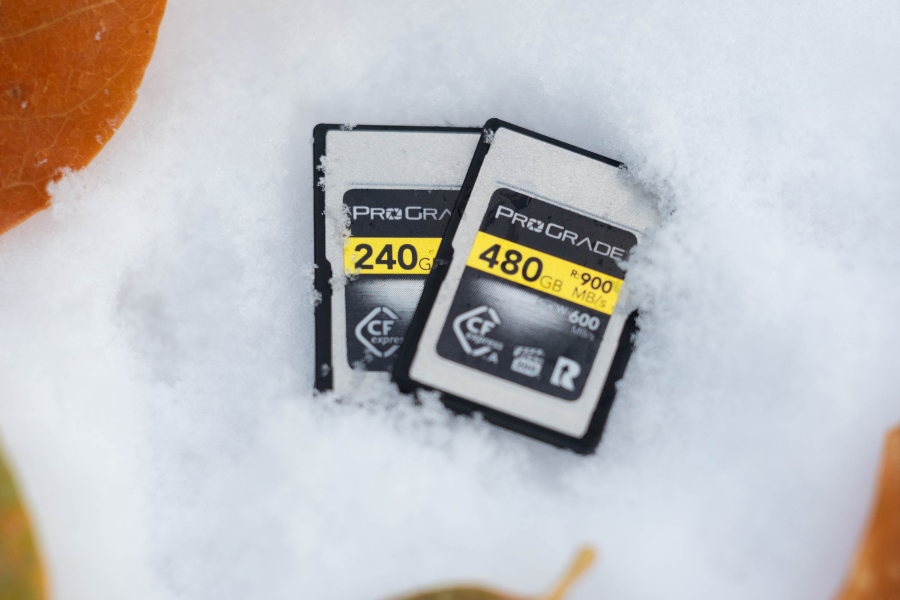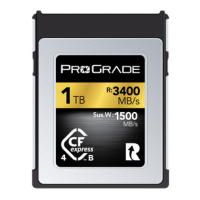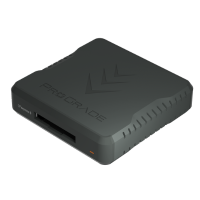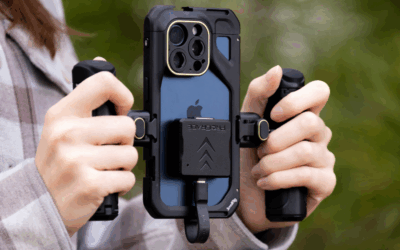You’re crouched in the dust, chasing golden hour light. Or maybe you’re elbow-deep in rainforest humidity, capturing a rare moment that won’t repeat itself. The camera’s rolling, the pressure is high—you’ve nailed the shot.
And then you find out it’s gone.
Not because you missed focus. Not because the timing was off. But because the memory card failed. Corrupted. Unreadable. All that effort, vision, and precision—lost to a tiny piece of tech that couldn’t take the heat. Or the cold. Or the impact.
Bringing home the shot is more than capturing it. It’s trusting that your gear can carry it all the way through—out of the storm, the sand, the chaos—without flinching. That’s where memory card durability matters most.
In this article, we’ll break down what actually makes a memory card durable, why it matters for working professionals, and how ProGrade memory cards are built to deliver under pressure—time and time again.
Build Quality & Materials: Why the Physical Design of a Memory Card Matters
Memory cards may be small, but what they’re made of—and how they’re built—plays a critical role in how well they stand up to repeated use, environmental stress, and the demands of professional shooting.
At the core, every memory card relies on solid-state storage, which has no moving parts. This is already a durability advantage over older mechanical storage, but not all solid-state memory is equal. The type of NAND flash used, the quality of the controller, and even how heat is managed across the internal structure can affect how long the card will last and how consistently it performs under pressure.
Just as important is the card’s outer casing—something that often goes unnoticed until it fails. Cards are routinely inserted, removed, transported, and sometimes dropped. Thin plastic shells or poorly bonded seams are far more likely to crack, warp, or lose connection with internal components. Durable cards, by contrast, use reinforced materials and precise assembly tolerances to maintain integrity even after thousands of insertions or exposure to rough handling.
Thermal resistance is another crucial factor. Shooting in hot climates, direct sunlight, or high-frame-rate modes generates internal heat, not just in your camera but in the card itself. A well-designed card disperses that heat efficiently to prevent thermal throttling or premature wear—something that often separates professional-grade options from consumer-level gear.
It’s a design philosophy rooted in real-world performance—and one that ProGrade strongly relies on across its entire lineup.
None of this is flashy. You won’t see it from the outside. But it’s exactly these structural choices—stronger shells, higher-grade memory, better thermal design—that determine whether a card quietly does its job or fails when it matters most.
Resistance to Harsh Conditions: What Real-World Durability Looks Like
Harsh environments expose the weak points in any piece of gear—and memory cards are no exception. Between temperature fluctuations, moisture, impact, and vibration, the conditions many photographers and filmmakers work in can be brutal.
Heat buildup during continuous shooting, cold mornings on location, high humidity, and even airport X-ray machines all push a card’s physical integrity and data retention to the edge. And then there’s the rough handling: dropped bags, rushed card swaps, pressure from repeated insertions. A truly durable card isn’t just resistant to failure—it’s built with these stressors in mind from day one.
ProGrade memory cards are engineered to meet the demands of these environments head-on. With an operating temperature range from -25°C to 85°C, they’re built to function reliably in both freezing alpine mornings and sun-soaked desert afternoons. Shock resistance, X-ray protection, and built-in safeguards against electrostatic discharge help protect valuable data during travel and field use. It’s a durability approach that prioritizes consistent performance, no matter how unpredictable the shoot becomes.
That’s the standard professionals expect and why renowned sports photographer Jeff Cable—who’s covered multiple Olympic Games—relies on ProGrade memory cards in high-pressure, high-velocity shooting environments. It’s the same reason Nat Geo filmmaker Filipe DeAndrade puts them to work in jungles, oceans, and deserts. And why the World Rally Championship equips all WRC in-car camera systems with shock-resistant ProGrade cards—gear that has to survive collisions, cold, and constant vibration without missing a frame.
Data Integrity & Internal Durability
Durability isn’t just about the shell. Most card failures happen internally—caused by microscopic stress, electrical noise, or memory wear over time. To survive years of heavy use, a card needs built-in systems that constantly manage, correct, and optimize how data is handled.
Every time a file is written to a memory card, a chain of systems kicks in—systems designed not just to store data, but to protect it, distribute it efficiently, and preserve the card’s long-term performance. These systems aren’t visible from the outside, but they’re fundamental to how a professional-grade card stays reliable over time.
Error Correction
When you write data to a card—especially large, high-speed bursts—tiny electrical fluctuations can cause bit-level errors. One flipped bit isn’t visible in the moment, but over time, those minor faults can turn into corrupted files.
To prevent that, ProGrade cards are designed with an error correction code (ECC). It works like a proofreader, constantly checking data as it’s written and flagging anything that doesn’t match expected patterns. ECC can reconstruct the correct information using parity logic when an error is spotted.
In ProGrade cards, ECC is implemented at the controller level, close to the memory itself—where it can operate in real-time without slowing down performance. This balance of speed and accuracy is key in high-pressure environments where data must be written and protected simultaneously. As data moves between the camera and the memory cells, subtle inconsistencies can occur.
Wear Leveling
Flash memory wears out over time—the more you write to it—but the wear isn’t uniform. Some sectors get hit far more often than others, especially in workflows where you fill only part of the card.
When you continuously, day after day, shoot 20GB to a 128GB card, you put extra stress on the “front end” of the flash memory pane while leaving the rest of the memory cells untouched. This can cause your memory card to wear out faster.
Should you then not empty your card after each shoot and instead format it when it becomes full? No. That’s where wear leveling comes in.
Wear leveling is a data-handling strategy that distributes write cycles evenly across the memory cells so no section becomes overused or a failure point. Without it, you’d see bad sectors long before the card was technically “old.”
In ProGrade cards, the wear-leveling algorithm is built into the controller firmware. Memory cards are used for different applications and on different devices, all with unique usage patterns. We in ProGrade build cards for photographers and filmmakers and tune our wear-leveling algorithms for the demands of modern high-resolution photography and cinematography workflows.
This isn’t just about longevity—it’s about consistent, stable performance even after hundreds of uses. The goal isn’t just to last—it’s to last well.
Firmware
The firmware on a memory card is often invisible to the user, but it’s responsible for everything from how the card manages heat to how efficiently it communicates with your camera. Poor firmware leads to slowdowns, data loss, or sudden incompatibility. It’s the part of the card you never see but rely on every single time you press record.
This is exactly why we put extra effort into ensuring every ProGrade card has well-written firmware that handles buffer management, error logging, thermal behavior, and more—all without the user ever needing to intervene. And when standards evolve, firmware can be updated via our free Refresh Pro software, extending the life and reliability of the card even further.
7 Practical Tips for Maximizing Memory Card Life
Even the most robust cards benefit from proper handling. A few consistent habits can go a long way in extending the life of your memory cards and protecting the data they hold. Here are some best practices worth building into your workflow:
1. Format Cards in Camera Before Each Shoot
Always format your card using the camera you’ll be shooting with. This ensures file structure compatibility and minimizes the risk of errors or slowdowns during recording.
2. Handle Cards Carefully
Insert and remove cards gently. Avoid touching the contact pins, and never force a card into a slot. When not in use, store cards in a dedicated memory card case—not loose in a pocket or gear bag.
3. Use Reliable Readers and Cables
Low-quality card readers or cables with cheap connectors can interrupt transfers and corrupt files. Choose a well-built, high-speed reader to ensure stable, error-free data handling.
4. Power Down Before Removing the Card
Even after you stop recording, your camera may still write buffered data to the card. Always turn off the device before removing a card to ensure you do not interrupt this process and accidentally corrupt your data.
5. Don’t Delete Files Mid-Shoot
Avoid deleting individual files during a shoot. It can fragment the memory and increase long-term wear. Instead, back up your files and format the card between uses.
6. Use Multiple (High-Quality) Cards
Using multiple cards eliminates the need to delete files mid-shoot to free up space. This helps avoid not only fragmenting your cards but also accidental deletions.
7. Monitor and Maintain Your Cards
Formatting in-camera before each shoot is good practice, but over time it leaves behind data fragments that can reduce performance. Occasionally, formatting the card on a computer helps eliminate this buildup.
ProGrade users can go a step further with Refresh Pro—a free tool that not only allows you to reset your memory card’s flash memory to factory-fresh condition, but also monitors card health.
Refresh Pro provides health diagnostics, so you’ll know exactly in what shape your memory card’s memory cells are and when it’s time to retire a card. Checking your cards before a big shoot is a great way to avoid unexpected surprises. It’s a simple way to keep performance consistent and replace cards before problems start.
Final Thoughts: Memory Card Durability
Capturing the shot is only half the story. Getting it home intact—through heat, motion, long hours, and countless transfers—is where true reliability shows up.
At ProGrade, we design our memory cards with that reality in mind. And by understanding how these systems work—and maintaining them with care—you give your cards the best chance to perform exactly when you need them to.
Your focus stays where it belongs: on the moments that matter.
Happy shooting!
Explore ProGrade Digital memory card lineup >
Use our free memory card compatibility charts to find the best card for your workflow >





